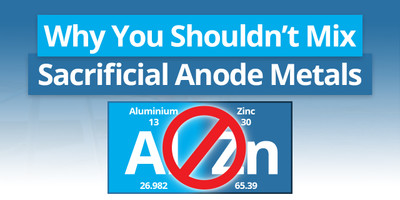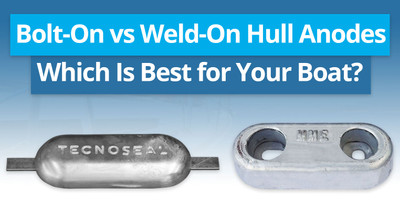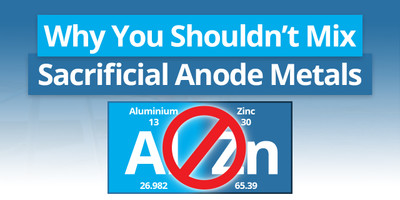25th Jul 2025
When it comes to protecting your boat from corrosion, sacrificial anodes are your first line of defence. These small metal components play a huge role in preserving your underwater metal fittings like shafts, propellers, and hull by corroding in place of more critical and expensive parts. But a common mistake boat owners make is mixing different anode metals on the same vessel. While it may seem harmless, mixing anode types can actually reduce their effectiveness and put your boat at risk.
In this post, we’ll explain:
- What sacrificial anodes do.
- The differences between anode metals.
- Why mixing them is a bad idea.
- How to choose the right anode for your boat.
What Are Sacrificial Anodes?
Sacrificial anodes are designed to corrode instead of the more vital metal parts of your boat that are submerged in water. This process is known as cathodic protection. When two different metals are connected in water, they form a galvanic cell, and one of the metals becomes the anode and corrodes. Sacrificial anodes deliberately become the anode in this equation.
They are typically bolted or clamped onto hulls, shafts, rudders, trim tabs, and other exposed metalwork, and must be replaced when sufficiently worn.
The Main Types of Sacrificial Anode Metals
There are three common metals used for anodes:
Zinc (Zn)
- Traditional anode metal.
- Best suited for saltwater use.
- Less effective in brackish or freshwater.
- Can become coated in freshwater, rendering it useless.
Aluminium (Al)
- Suitable for both saltwater and brackish environments.
- Lighter and lasts longer than zinc.
- Offers good all-round performance.
- Becoming increasingly popular due to environmental concerns.
Magnesium (Mg)
- Designed for freshwater use only.
- Too reactive for saltwater (can deplete rapidly).
- Offers strong protection in freshwater, but will overprotect in saltwater, leading to blistering or coating damage.
Why You Shouldn’t Mix Anode Metals
Using different anode metals on the same boat creates a conflict in protection potential. Each metal has a different voltage (or electrochemical potential) and corrosion rate. When you mix them, several problems can occur:
- Electrochemical Imbalance:
The anode with the higher potential (usually magnesium) will sacrifice itself much faster than intended, while the less active anodes (like zinc or aluminium) may not activate at all. This leads to uneven protection and can leave parts of your boat exposed to corrosion.
- Wasted Protection:
The more reactive anode will do most of the work and wear out quickly, while the other anodes remain largely untouched. This not only wastes money, but also risks your boat going unprotected if the active anode is depleted without your noticing.
- Ineffective Cathodic Protection:
The effectiveness of cathodic protection relies on a consistent electrochemical balance. Mixing metals disturbs this balance and can reduce the total protective effect, increasing the chance of galvanic corrosion affecting vital components.
How to Choose the Right Anode Metal
The best anode metal for your boat depends on the type of water you operate in:
Stick with one metal type throughout your entire system - hull anodes, shaft anodes, trim tabs, and any other fittings. Consistency ensures optimal protection across all components.
Summary
Sacrificial anodes are a critical part of your boat’s defence against corrosion, but using the wrong type - or mixing different metals - can drastically reduce their effectiveness. Always match your anode metal to your boating environment, and make sure every anode on the vessel is of the same material.
If you're unsure which anode is right for your boat, speak to a marine specialist or consult your boat’s manufacturer. A small investment in the right anodes now can save thousands in repairs later.
Need help choosing the right anode?
Our expert team are here to help should you have any questions - whether that be regarding metals, shapes or sizes - or anything else! Call us on 01634 568011 or visit our contact us page for more information on how to get in touch.



